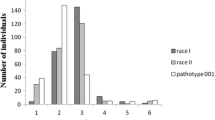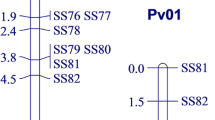Abstract
Breeding for host resistance to coffee berry disease (CBD) in arabica coffee (Coffea arabica) was initiated some 35–40 years ago in Kenya, Ethiopia and Tanzania in response to severe CBD epidemics. The release of CBD resistant cultivars to the coffee growers has been in progress since 1985. The resistance of cultivars like Ruiru 11 (Kenya) and Ababuna (and other cvs in Ethiopia) appears to be of a durable nature, since confirmed cases of a breakdown of host resistance under field conditions have not been reported over the past 20 years. Host resistance to the hemibiotrophic fungus Colletotrichum kahawae is of a quantitative nature, but nevertheless can be practically complete in some genotypes of arabica coffee. There is still no consensus on the genetics of CBD resistance, some claiming convincing evidence for oligogenes (1–3 major genes) and others for polygenes determining CBD resistance. Results from genetic studies with germplasm from the centre of genetic diversity for C. arabica in Ethiopia are presented here. These together with the recent identification of molecular markers associated with and the mapping of one major gene, provides additional evidence for oligogenic inheritance of CBD resistance. The development of cultivars combining yield and quality with durable host resistance to CBD has contributed greatly to increased sustainability of arabica coffee production in Africa. It has also considerable relevance to arabica coffee in Latin America and Asia, where CBD is still a quarantine disease but with a risk of becoming endemic one day, just as has happened earlier with coffee leaf rust (Hemileia vastatrix).




Similar content being viewed by others
References
Anon (2005) Progress report 2004–2005. EU/INCO/ICA4-CT-2001-10008/CBDRESIST Project
Bailey JA, O’Connel RJ, Pring RJ, Nash C (1992) Infection strategies of Colletotrichum species. In: Bailey JA, Jeger MJ (eds) Colletotrichum: biology pathology and control. British Society of Plant Pathology. CAB International, Wallingford, UK, pp 88–119
Bellachew B (2001) Arabica coffee breeding for yield and resistance to coffee berry disease (Colletotrichum kahawae sp. nov.). PhD Thesis, Department of Agriculture, Imperial College at Wye, University of London, UK, 272 pp
Bellachew B, Atero B, Tefera F (2000) Breeding for resistance to coffee berry disease in arabica coffee: progress since 1973. Proceedings of the workshop on control of coffee berry disease (CBD) in Ethiopia, Addis Ababa, 13–15 August 1999. Jimma Agricultural Research Center (JARC), Ethiopia, pp 85–98
Bella Manga (1999) Etude de la diversité de Colletotrichum kahawae responsable de l’anthracnose des baies et caractérisation de la résistance du caféier Arabica à cet agent pathogène. Thèse Docteur en Sciences, Université Montpellier II, Sciences et Technique du Langedoc, France, 145 pp
Bettencourt AJ, Rodrigues CJ (1988) Principles and practice of coffee breeding for resistance to rust and other diseases. In: Clarke RJ, Macrae R (eds) Coffee, vol. 4 agronomy. Elsevier Applied Science, London & New York, pp 199–234
Chen Z, Nunes MA, Silva MC, Rodrigues CJ Jr (2004) Appressorium turgor pressure of Colletotrichum kahawae might have a role in coffee cuticle penetration. Mycologia 96:1199–1208. doi:10.2307/3762135
Cook RTA (1973) Screening coffee plants for CBD resistance. Annual report Coffee Research Foundation, Kenya 1972/73: 66–68
Fernandez D, Santos P, Agostine C, Bon MC, Petitot AS, Silva MC et al (2004) Coffee (Coffea arabica L) genes early expressed during infection by the rust fungus (Hemileia vastatrix). Mol Plant Pathol 5(6):527–536. doi:10.1111/j.1364-3703.2004.00250.x
Flood J, Waller JM (2001) Coffee diseases: a clear and present danger. In: Baker PS (ed) Coffee futures a source book of some critical issues confronting the coffee industry. CABI Commodities, Egham, UK, pp 82–93
Gichuru EK, King’ori PN, Masaba DM (1999) Histological differences during infection of Coffea arabica varieties by Colletotrichum kahawae isolates. Proceedings 18th International Scientific Colloquium on Coffee, Helsinki, Finland. ASIC, Paris, France, pp 477–479
Gichuru EK, Agwanda CO, Combes MC, Mutitu EW, Ngugi ECK, Bertrand B, et al (2008) Identification of molecular markers linked to a gene conferring resistance to coffee berry disease (Colletotrichum kahawae) in Coffea arabica L. Plant Pathology. doi:10.1111/j.1365-3059.2008.01846x
Guillaumet JL, Hallé F (1971) Echantillonnage du matériel Coffea arabica récolté en Ethiopie. In: A Charrier (ed.) Etude de la structure et de la variabilité génétique des Caféiers. IFCC, Paris, Bulletin no 14, pp 13–18
Masaba DM, Van der Vossen HAM (1982) Evidence of cork barrier formation as a resistance mechanism to berry disease (Colletotrichum coffeanum) in arabica coffee. Neth J Plant Pathol 88:19–32. doi:10.1007/BF01976423
Meyer FG, Fernie LM, Narasimhaswamy RL, Monaco LC, Greathead DJ (1968) FAO Coffee Mission to Ethiopia 1964–65. FAO Rome. 200 pp
Omondi CO, Pinard F (2006) Screening populations of arabica coffee for molecular markers linked to coffee berry disease resistance. Proceedings 21st International Scientific Colloquium on Coffee, Montpellier, France. ASIC, Paris, France, 1377–1379
Omondi CO, Ayiecho PO, Mwang’ombe AW, Hindorf H (2001) Resistance of Coffea arabica cv. Ruiru 11 tested with different isolates of Colletotrichum kahawae, the causal agent of coffee berry disease. Euphytica 121:19–24. doi:10.1023/A:1012056622969
Omondi CO, Agwanda CO, Gichuru EK (2004) Field expression of resistance to coffee berry disease (CBD) as affected by environment and host–pathogen factors. Proceedings 20th International Scientific Colloquium on Coffee, Bangalore, India. ASIC, Paris, France, pp 1216–1221
Opile WR, Agwanda CO (1993) Propagation and distribution of cultivar Ruiru 11: a review. Kenya Coffee 58(677):1496–1508
Silva MC, Várzea V, Guerra-Guimarães L, Gil Azinheira H, Fernandez D, Petitot AS, Bertrand B, Lashermes PH, Nicole M (2006) Coffee resistance to the main diseases: leaf rust and coffee berry disease. Braz J Plant Physiol 18:119–147. doi:10.1590/S1677-04202006000100010
Teri JM, Kilambo DL, Mtenga DJ, Nyange NE, Nzallawahe TS, Chipungahelo GS, et al (2004) Improved arabica varieties for the benefit of Tanzanian coffee growers. Proceedings 20th International Scientific Colloquium on Coffee, Bangalore, India. ASIC, Paris, France, pp 1187–1191
Thomas AS (1942) The wild arabica coffee on the Boma Plateau of Anglo-Egyptian Sudan. Emp J Exp Agric 10:207–212
Van der Graaff NA (1981) Selection of arabica coffee types resistant to coffee berry disease in Ethiopia. PhD Thesis (Communications no. 8–11), Agricultural University of Wageningen, the Netherlands, 111 pp
Van der Vossen HAM (2001) Coffee breeding practices. In: Clarke RJ, Vitzthum OG (eds) Coffee-recent developments. Blackwell Science, Oxford, pp 184–201
Van der Vossen HAM, Waweru JM (1977) A temperature controlled inoculation room to increase efficiency of preselction for resistance to coffee berry disease. Kenya Coffee 41:164–167
Van der Vossen HAM, Walyaro DJ (1980) Breeding for resistance to coffee berry disease in Coffea arabica L. II. Inheritance of the resistance. Euphytica 29:777–791. doi:10.1007/BF00023225
Van der Vossen HAM, Walyaro DJ (1981) The coffee breeding programme in Kenya: a review of progress made since 1971 and plan of action for the coming years. Kenya Coffee 46:113–130
Van der Vossen HAM, Cook RTA, Murakaru GNW (1976) Breeding for resistance to coffee berry disease caused by Colletotrichum coffeanum Noack (sensu Hindorf) in Coffea arabica L. I. Methods of preselection for resistance. Euphytica 25:733–745. doi:10.1007/BF00041613
Waller JM (1971) The incidence of climatic conditions favourable to coffee berry disease in Kenya. Exp Agric 7:303–314
Acknowledgement
This paper is published with permission of the Director of Research, Coffee Research Foundation, Kenya.
Author information
Authors and Affiliations
Corresponding author
Rights and permissions
About this article
Cite this article
van der Vossen, H.A.M., Walyaro, D.J. Additional evidence for oligogenic inheritance of durable host resistance to coffee berry disease (Colletotrichum kahawae) in arabica coffee (Coffea arabica L.). Euphytica 165, 105–111 (2009). https://doi.org/10.1007/s10681-008-9769-3
Received:
Accepted:
Published:
Issue Date:
DOI: https://doi.org/10.1007/s10681-008-9769-3




